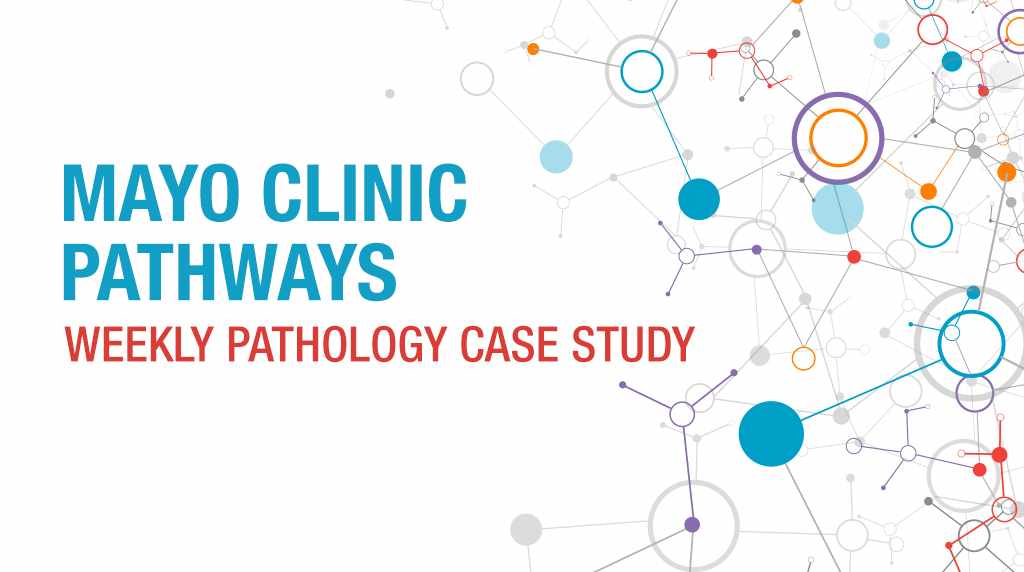-
Minnesota
Mayo Clinic Releases PathWays: New Online “Case Study” Tool for Pathologists and Medical Enthusiasts
Mayo Clinic fellows and residents publishing weekly practical case studies on the Mayo Medical Laboratories blog for medical professionals around the world.
ROCHESTER, Minn. — A dark purplish blob (a.k.a., a karyosome) floats randomly next to perfectly pink circles. Electric yellow spots stand out in a sea of stained dark blue cells, viewed at 40 times the original magnification. For a pathologist, this unique “artwork” provides vital information that will unlock needed medical diagnoses for sick patients. These scientific images — combined with brief patient descriptions — comprise Mayo Clinic PathWays — an online learning tool for pathologists and for those who enjoy learning about medicine. Mayo Medical Laboratories and Mayo Clinic’s Laboratory Medicine and Pathology Graduate Medical Education Office have developed this case-study tool that will offer weekly “challenges” posted to the Mayo Medical Laboratories website.
MEDIA CONTACT: Gina Chiri-Osmond, Public Affairs, 507-284-5005, newsbureau@mayo.edu

“We have a wonderful opportunity here to bring practical case studies from our fellows and residents within the Mayo Clinic Department of Laboratory Medicine and Pathology to pathology professionals around the world in an intriguing, professional and engaging manner,” says Bobbi Pritt, M.D., a pathologist and vice chair of Education, Mayo Clinic Department of Laboratory Medicine and Pathology.
To meet teaching requirements of accreditation bodies and the Mayo Clinic Laboratory Medicine and Pathology Graduate Medical Education Office, fellows, residents and consultants will craft the case studies (complete with images and patient vignettes) and have the case studies vetted by Mayo Clinic faculty consultants. The case studies will initially focus on both the anatomic and clinical pathology disciplines.
“Through this project, our laboratory medicine and pathology consultants and trainees will integrate education, clinical practice and research via weekly cases,” says Dr. Pritt. “The goal is peer-to-peer education, but we also want to disseminate what we’ve learned to a larger audience in a free online instructive environment.”
Each week, readers of the Mayo Medical Laboratories blog can assume the role of a pathologist by evaluating a selected case, assessing the medical information and committing to a diagnosis by voting from four possible choices. The tool will explain why an answer is correct or inaccurate.
In the future, case studies will also be provided by the Mayo Clinic Center for Individualized Medicine and other scientific centers of excellence.
View this week's case study here.
###
About Laboratory Medicine and Pathology at Mayo Clinic
The Mayo Clinic Department of Laboratory Medicine and Pathology and its reference laboratory, Mayo Medical Laboratories, provide advanced laboratory testing and pathology services to support 4,000 health care organizations around the world. Revenue from this testing is used to support medical education and research at Mayo Clinic, a nonprofit worldwide leader in medical care, research and education for people from all walks of life. Complemented by collaborations with diagnostic and biotechnology companies, the department maintains a robust diagnostic test-development program, launching more than 150 new tests annually.
About Mayo Clinic
Mayo Clinic is a nonprofit organization committed to medical research, education and providing expert, whole-person care to everyone who needs healing. For more information, visit http://www.mayoclinic.org/about-mayo-clinic or https://newsnetwork.mayoclinic.org/.








